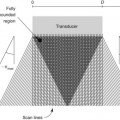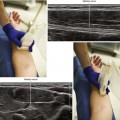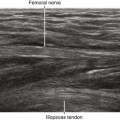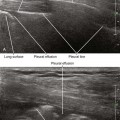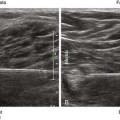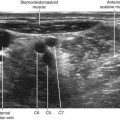36 Median Nerve Block
In the forearm the median nerve lies between the flexor digitorum profundus and the flexor digitorum superficialis muscles. This is where the median nerve is usually brightest on ultrasound scans.1
The two largest branches of the median nerve are the anterior interosseous nerve and the palmar cutaneous branch. About 5 to 8 cm distal to the lateral epicondyle, the anterior interosseous nerve (a purely motor nerve) branches off the median nerve. It travels deep to the median nerve between the flexor pollicis longus and flexor digitorum profundus (both of which it innervates). The palmar cutaneous branch of the median nerve arises 5 cm proximal to the wrist crease on the radial side of the nerve.2,3
Suggested Technique
With ultrasound, the median nerve is usually blocked in the mid-forearm because it is echobright without adjacent tendons.1 This location is also chosen because it is away from the carpal tunnel, proximal to the palmar cutaneous branch takeoff, but distal to the anterior interosseous motor branch takeoff. In the mid-forearm, the median nerve lies within the fascial plane between the flexor digitorum superficialis and profundus, which provides a means for targeting drug injections without nerve contact. The block is performed on the volar side of the forearm with the arm supinated. Both in-plane and out-of-plane approaches can be used for these blocks. Steep in-plane approach to the median nerve from the lateral aspect of the forearm avoids the radial artery and the superficial radial nerve.
The hand should be relaxed so that the median nerve is mobile and not under tension. Wrist hyperextension stretches the median nerve and can lead to impairment of nerve function if prolonged.4 Therefore, median nerve block should be performed with the wrist in neutral position.
Near the elbow the median nerve lies medial to the brachial artery. Median nerve block proximal to the elbow is often used in the recovery room following surgery because of the presence of surgical dressings covering the forearm. If this approach is used, care must be taken to avoid puncturing the brachial artery because this can result in median epineurial hematoma.5,6
Although the median artery normally evolutes during development, persistent median artery can be detected with high-resolution ultrasound in about 25% of asymptomatic individuals.7
Stay updated, free articles. Join our Telegram channel

Full access? Get Clinical Tree


